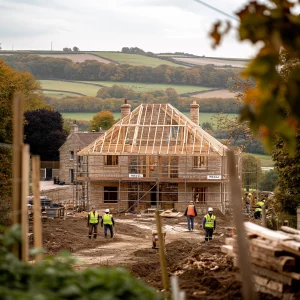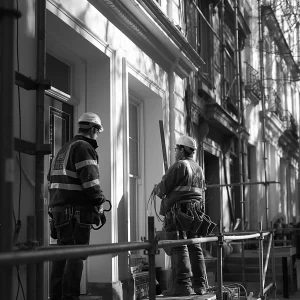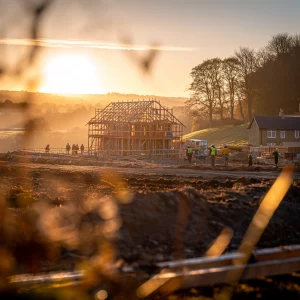Building Success: How to Comply with Local Building Codes in the UK
Navigating Building Regulations in the UK
Navigating the labyrinth of building regulations in the United Kingdom can be daunting for homeowners, construction companies, and property owners. These statutory instruments, which enforce legislative policy in construction, are crucial for ensuring construction projects’ structural safety, efficiency, and sustainability. It’s essential to understand that UK building regulations are distinct from planning permissions, which generally focus more on aesthetics and land use.
Understanding the Framework
Building regulations in the UK vary significantly across England, Wales, Scotland, and Northern Ireland, with each region maintaining its own governmental oversight and distinct regulatory frameworks. This decentralisation means that the rules applicable in one part of the UK may not necessarily apply in another, necessitating a localised approach to compliance.
The regulations themselves cover a broad spectrum of construction aspects. These include, but are not limited to, structural integrity, fire safety, sound insulation, ventilation, energy conservation, accessibility, and security. The objective is to ensure that buildings are safe for occupants and contribute positively to the surrounding environment and community.
The Role of Approved Documents
Compliance with building regulations is often achieved through adherence to “approved documents.” These documents provide guidelines that describe ways to meet the requirements of the regulations. Importantly, they offer guidance rather than prescribe mandatory methods, allowing for alternative compliance solutions that can be particularly useful in complex construction projects. This flexibility is vital for fostering innovation and adapting to specific site conditions.
Dynamic Regulatory Environment
The regulatory environment in construction is dynamic and continually adapting to new technological advances and societal needs. For instance, a heightened focus has been on increasing energy efficiency and enhancing safety measures, particularly following significant events such as the tragic Grenfell Tower fire. Such incidents have spurred revisions in regulations to prevent future occurrences and ensure higher safety standards.
Importance of Timely Compliance
For construction projects, securing timely permits and adhering strictly to building codes are fundamental to avoiding legal penalties, project delays, and financial burdens. It’s critical to understand the distinctions between the types of permits required—ranging from planning permission and building regulations approval to specific consents for protected sites.
The Professional’s Role
Professionals in the construction industry play an indispensable role in navigating these complex regulations. Their expertise ensures that projects comply with the latest standards and secure all necessary permits before proceeding. The involvement of qualified professionals is essential in mitigating risks associated with non-compliance, which can include legal action and substantial penalties.
Oversight by Building Safety Regulator
In the UK, the Building Safety Regulator (BSR) oversees building control entities, primarily focusing on maintaining high standards across the board. An important initiative currently underway is the requirement for all building inspectors in England to complete competency assessments by July 2024. This move is part of a broader effort to enhance the reliability and accountability of those responsible for safety checks and compliance certifications.
Legal Implications of Non-Compliance
The UK Building Regulations 2010 (BR 2010) encapsulates the legal framework governing building regulations, underpinned by the Building Act 1984. These laws mandate strict compliance with regulations that ensure structural and fire safety, among other factors. Failure to comply can lead to severe consequences, including legal actions and penalties. It underscores the importance of understanding and adhering to the rules in the twelve Approved Documents, which provide detailed guidance across various aspects of construction.
Engaging with the Regulatory Approval Process
The process of obtaining regulatory approval for building projects in the UK involves several critical steps, each designed to ensure that every aspect of a construction project meets the stringent requirements outlined in the building regulations. Understanding and navigating this process is essential for timely and successful project completion.
Step-by-Step Compliance
First, it’s important to determine which regulations and approvals apply to a specific project. This determination often requires a detailed assessment of the project’s scope, location, and intended use. Once the applicable regulations are identified, the next step involves the preparation of detailed plans and documents that demonstrate how the proposed construction will comply with the relevant regulations.
Professionals, such as architects and engineers, play a crucial role in this phase. They prepare drawings, structural calculations, and other technical documents that will be reviewed by building control bodies. These professionals ensure that the designs adhere to all aspects of the approved documents, from fire safety measures to energy efficiency and accessibility.
Securing Building Control Approval
Once the necessary documentation is prepared, the next step is to submit these documents to the local building control body for approval. This body may be a local council or an approved inspector who will assess the plans to ensure they meet all regulatory requirements. If further clarifications or modifications to the plans are needed, the review process may involve several iterations.
Construction can begin after the plans are approved. However, compliance does not end with plan approval. Throughout the construction phase, periodic inspections are required to ensure that the work is carried out according to the approved plans and regulations. These inspections are crucial as they continuously check against the agreed safety and quality standards.
Final Certification and Completion
Upon completion of the construction, a final inspection is conducted. If the building control body is satisfied that the completed project complies with the building regulations, a completion certificate is issued. This certificate is an important document, as it is often required to sell the property or for business licensing if the building is commercial.
Continuous Adaptation to Changing Standards
The building regulations in the UK are subject to continuous review and adaptation to accommodate new building techniques, materials, and changes in public policy. For example, the shift towards more sustainable construction practices has led to updated regulations focusing more intensely on environmental impact, energy usage, and long-term sustainability.
Innovation and Alternative Solutions
The flexibility of the building regulations allows for the use of innovative materials and building techniques that may not be explicitly covered in the approved documents. In such cases, demonstrating compliance involves preparing a case that shows how the alternative solutions meet or exceed the standards set out in the regulations. This aspect of compliance encourages innovation within the industry while ensuring safety and quality are not compromised.
Professional Education and Training
Given building regulations’ complexity and ever-evolving nature, ongoing professional education and training are paramount. Construction industry professionals must stay informed about the latest changes to regulations and best practices. This is not only a requirement for maintaining professional licenses but is also critical for ensuring they can provide their clients with the best advice and service.
Final Thoughts
The regulatory approval process for building in the UK is intricate. It requires a deep understanding of both the specific regulations that apply to each project and the broader legal and safety implications.
By engaging with this process thoughtfully and thoroughly, with the support of qualified professionals, construction projects can proceed smoothly, meeting all necessary standards and contributing positively to the built environment. This adherence ensures compliance and enhances the safety, usability, and sustainability of buildings throughout their lifecycle.















